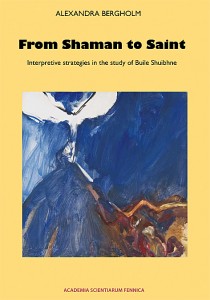Alexandra Bergholm: From Shaman to Saint: Interpretive strategies in the study of Buile Shuibhne
A shaman, a saint, a remorseful penitent, or a mad novice? Since the publication of J. G. O’Keeffe’s edition of the medieval Irish text Buile Shuibhne in 1913, the enigmatic presentation of its main protagonist Suibhne Geilt has become a subject of a plurality of scholarly analyses, which have sought to understand the true nature of his madness. This study charts the ways in which Buile Shuibhne has been interpreted in twentieth-century scholarship, by paying particular attention to the religious allegorical readings of the text. The examination of four prevalent interpretative frameworks – historical, pre-Christian, Christian, and anthropological – relates theoretical conceptions of literary theory, comparative religion and historiography to the study of medieval narrative material, by considering the nature of different methodological presuppositions that have guided the scholars’ understanding of the tale’s meaning. The integration of issues relating to text, context, and interpretation raises the issue of communally shared reading strategies in the explication of interpretive variety, thereby highlighting the importance of asking not only what a text means, but also how it means.

